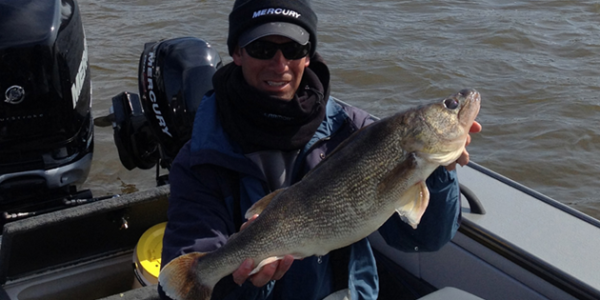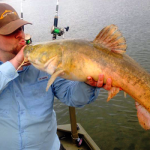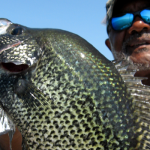By Roy Vivian
One of the biggest misconceptions in today’s walleye world is the encouragement to use the lightest jig possible. Walleyes are known to be finicky, and are short biters, thus the strategy is logical. Traditional thinking often says to use the lightest jig the current allows in order to maintain steady bottom contact. For instance, tip the jig with a fathead minnow, add a stinger hook, and you have the best method for catching walleyes. It’s a proven way to catch fish, but I prefer a more aggressive approach that doesn’t involve a minnow bucket.
Instead of using the lightest jig possible, I use the heaviest jig I can get away with on my medium light action G-Loomis rod. I have found a ½ oz. jig is the ticket. With a 5/8 oz. jig I lose control of the presentation and have to switch to a heavier, medium action rod. I prefer the feel of the medium light therefore in most cases I am using a ½ oz. jig.

Vivian places in the money quite frequently with his power jigging techniques, illustrated here. In the 2015 Illinois River MWC event, him and teammate Scott Pirnstill earned themselves a check.
Using a ½ oz. jig and plastic allows me to fish quickly and more aggressively. The heavier jig and its power fishing style simply triggers more bites and puts more fish in my Lund compared to a lighter jig and minnow. One of the key differences with this tactic is the bigger profile and pounding acts serves as an attractor. This is especially true when fishing key spring and fall hangouts on hard bottom areas of lakes and rivers. I employ an aggressive lift and drop jigging technique. When the jig hits the bottom, the noise and bottom disturbance draws fish in to investigate. Oftentimes, water clarity is less than a foot in the spring, therefore using a ½ oz. jig helps fish find the bait.
In post spawn conditions, I often experiment with adding a fathead minnow to a ½ oz. jig and a split tail Berkley Gulp! minnow. The minnow adds bulk to the presentation and provides a bigger profile. This technique was triggering big, post spawn, walleyes in the 2009 Red Wing FLW event held on the Mississippi River. Out of that tournament field of anglers, I believe I was the only person vertically jigging, and for I know for certain I was the only one pounding the bottom with ½ oz. jigs in water as shallow as 4 feet.
Look this one up yourselves right now on Google. Search for the subject, “pounding the bottom for walleyes.” Most of the results you will find are tactics used in ice fishing. This style of fishing has been the preferred presentation of ice fishermen for a long time. Not only does it work for walleyes, but also for bluegills and perch. Ice fishing is the ultimate way to vertical jig. It only makes sense that the same technique works when vertical jigging the rivers.
Using the right gear is extremely important to this technique. By using shorter length rods, you will have greater control over the action of the jig. I use a 6 ft. medium light rod. I would use a shorter rod if I could get away with it but the rod has to be long enough to reach out from the boat so you can comfortably fish. I use white Power Pro 2/10. The 2 lb. diameter reduces resistance and allows me to fish as vertical as possible. This line is strong enough to catch about anything that swims in the river, yet it is light enough that you can break the line when snagged. The high visibility white allows me to see my line and detect light bites.
Boat control is extremely important when pounding the bottom. The key is to stay as vertical as possible erring with the tip of the rod slightly upstream. Use the trolling motor to make proper adjustments to swirling winds and under-currents, all while dodging other boats. I use two rods unless the area I am fishing is full of snags. It is sometimes impossible to have both rods presented vertically at the same time. This is especially true if two anglers are fishing in the boat. I try to keep at least one of my rods vertical at all times. In tournament settings, the co-angler will have to move around a lot in order to keep vertical in the back of the boat. My MWC partner, Scott Pirnstill, is a master at this but it is a lot of work. Being in the back of the boat can be rewarding, as fish will often see those baits first.
Sometimes the fish will inhale the bait, creating a thump that you will feel all the way into your shoulder. Other times they hit it while the jig is falling and you will not feel the fish until you begin to lift the jig. I have heard Keith Kavajecz describe this as a “presence” bite, when lifting up and feeling weight. When you feel anything different, set the hook hard. These fish are often not hooked as well so I try to get that fish up to the surface, into the net as quickly as possible. For these reasons I tighten my drag to drive hooks into the fish.
In my opinion, the best jig for this technique is a Hutch teardrop jig. If you prefer to make them yourself, you can purchase a mold from Do-It Molds. In stained water I use orange jigs. I am not sure how important color is in triggering fish. I just know that I have caught a lot of fish on orange, which gives me confidence that it works. If I am fishing the same stretch of river over and over I will switch up to a chartreuse jig.
My favorite soft plastics to jig with are ringworms. In cold, clear water I will downsize and use a Gulp like split tail minnow. In water temperatures of 30 degrees and warmer I will experiment with numerous plastics like ringworms, paddle tails, shad baits, and twister tails. It is amazing to me what they will hit. In dirty water I will try bulkier plastics such as a Zoom Lizard.
When you are on a river this spring, tie on a ½ oz. jig and pound the bottom for some fast action. Traditional thinking often says to use the lightest jig the current allows in order to maintain steady bottom contact, but the preference of a more aggressive approach that doesn’t involve a minnow bucket often prevails, and wins.
Roy Vivian is a walleye tournament angler who has fished the MWC, AIM, FLW and NWT Circuits. He is on the Pro-Staff of Lund Boats, Mercury Motors, Shimano and EZEE Step. He has been a Fishing-Headquarters contributor since spring 2011, and much of his walleye wisdom can be read online. You can follow him on his fishing page: Roy Vivian Pro Walleye Angler






